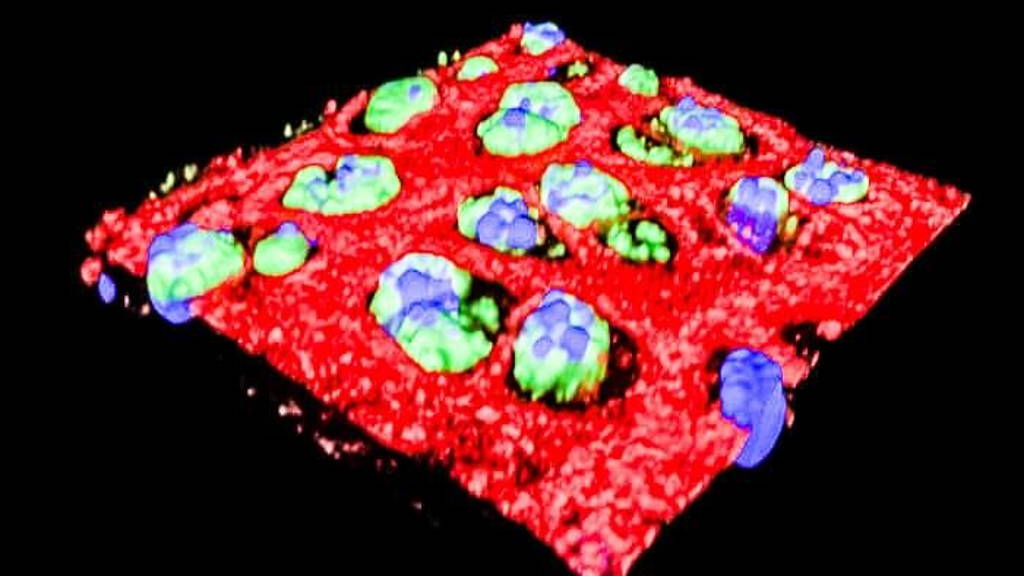The degenerative joint disease known as osteoarthritis is the most common chronic joint condition, afflicting millions of people worldwide. Nearly one in two people may develop symptomatic knee osteoarthritis by the age of 85. Osteoarthritis is a debilitating condition that affects at least 27 million people in the United States, and at least 12 percent of osteoarthritis cases stem from earlier injuries.
"I see a lot of patients with osteoarthritis, and there's really no treatment," senior author Dr. Christine Pham, an associate professor of medicine at Washington University, says in a statement. "We try to treat their symptoms, but even when we inject steroids into an arthritic joint, the drug only remains for up to a few hours, and then it's cleared.” The nanoparticles used on mice however, remain in the joint longer and help prevent cartilage degeneration.
The nanoparticles were injected shortly after an injury, and within 24 hours, they were at work taming inflammation in the joint. Unlike steroid injections that are quickly cleared, the particles remained in cartilage cells in the joints for weeks. The goal was to ward off cartilage degeneration that eventually results in osteoarthritis.
“The inflammatory molecule that we’re targeting not only causes problems after an injury, but it’s also responsible for a great deal of inflammation in advanced cases of osteoarthritis,” said Linda J. Sandell, PhD, the Mildred B. Simon Research Professor of Orthopaedic Surgery and director of Washington University’s Center for Musculoskeletal Research. “So we think these nanoparticles may be helpful in patients who already have arthritis, and we’re working to develop experiments to test that idea.”
The findings were reported online Sept. 26 in the early edition of the Proceedings of the National Academy of Sciences.
Pain relief
What happens is that the cartilage covering the ends of each bone breaks down, causing pain and swelling and making it difficult to move the joint. Current treatments include anti-inflammatory drugs and/or steroid injections depending on the severity of pain. However, relief can be brief as only the symptoms (such as pain) are adressed."I see a lot of patients with osteoarthritis, and there's really no treatment," senior author Dr. Christine Pham, an associate professor of medicine at Washington University, says in a statement. "We try to treat their symptoms, but even when we inject steroids into an arthritic joint, the drug only remains for up to a few hours, and then it's cleared.” The nanoparticles used on mice however, remain in the joint longer and help prevent cartilage degeneration.
Peptide-based nanoparticle
The peptide-based nanoparticle was designed by study co-investigators Hua Pan, PhD, an assistant professor of medicine, and Samuel Wickline, MD, the James R. Hornsby Family Professor of Biomedical Sciences. The nanoparticles used in the study are more than 10 times smaller than a red blood cell, which helps them penetrate deeply into tissues. The particles carry a peptide derived from a natural protein called melittin that has been modified to enable it to bind to a molecule called small interfering RNA (siRNA). The melittin delivers siRNA to the damaged joint, interfering with inflammation in cells.The nanoparticles were injected shortly after an injury, and within 24 hours, they were at work taming inflammation in the joint. Unlike steroid injections that are quickly cleared, the particles remained in cartilage cells in the joints for weeks. The goal was to ward off cartilage degeneration that eventually results in osteoarthritis.
Maintain cartilage viability
The findings suggest that the nanoparticles, if given soon after joint injuries occur, could help maintain cartilage viability and prevent the progression to osteoarthritis. But while the results show the nanoparticle treatment could effectively prevent the progression of joint injury to osteoarthritis, further studies are needed to see if the therapy could benefit a patient years after sustaining the injury and has already developed osteoarthritis.“The inflammatory molecule that we’re targeting not only causes problems after an injury, but it’s also responsible for a great deal of inflammation in advanced cases of osteoarthritis,” said Linda J. Sandell, PhD, the Mildred B. Simon Research Professor of Orthopaedic Surgery and director of Washington University’s Center for Musculoskeletal Research. “So we think these nanoparticles may be helpful in patients who already have arthritis, and we’re working to develop experiments to test that idea.”
The findings were reported online Sept. 26 in the early edition of the Proceedings of the National Academy of Sciences.






